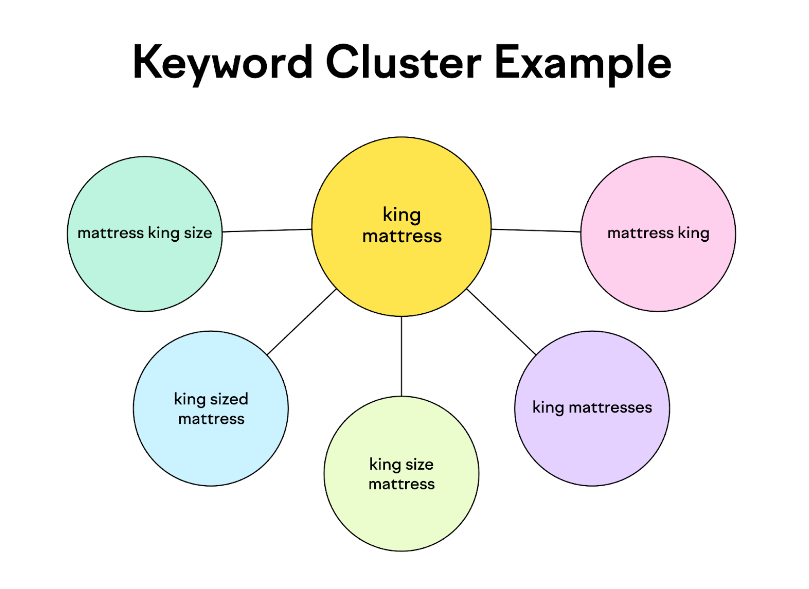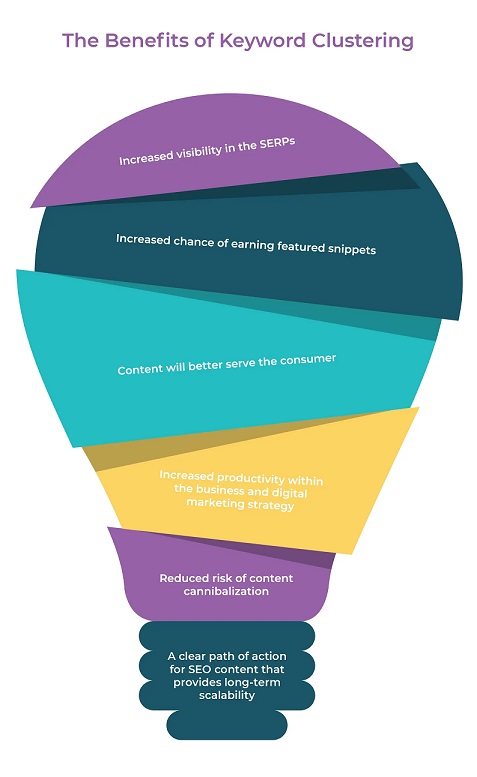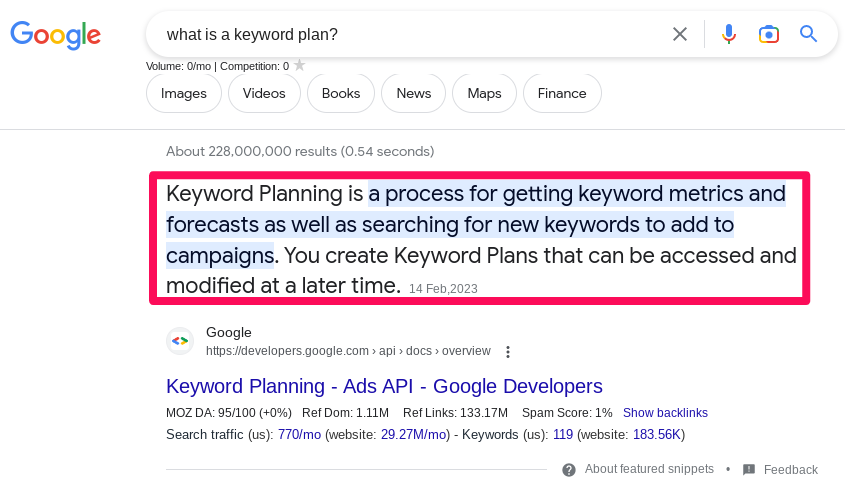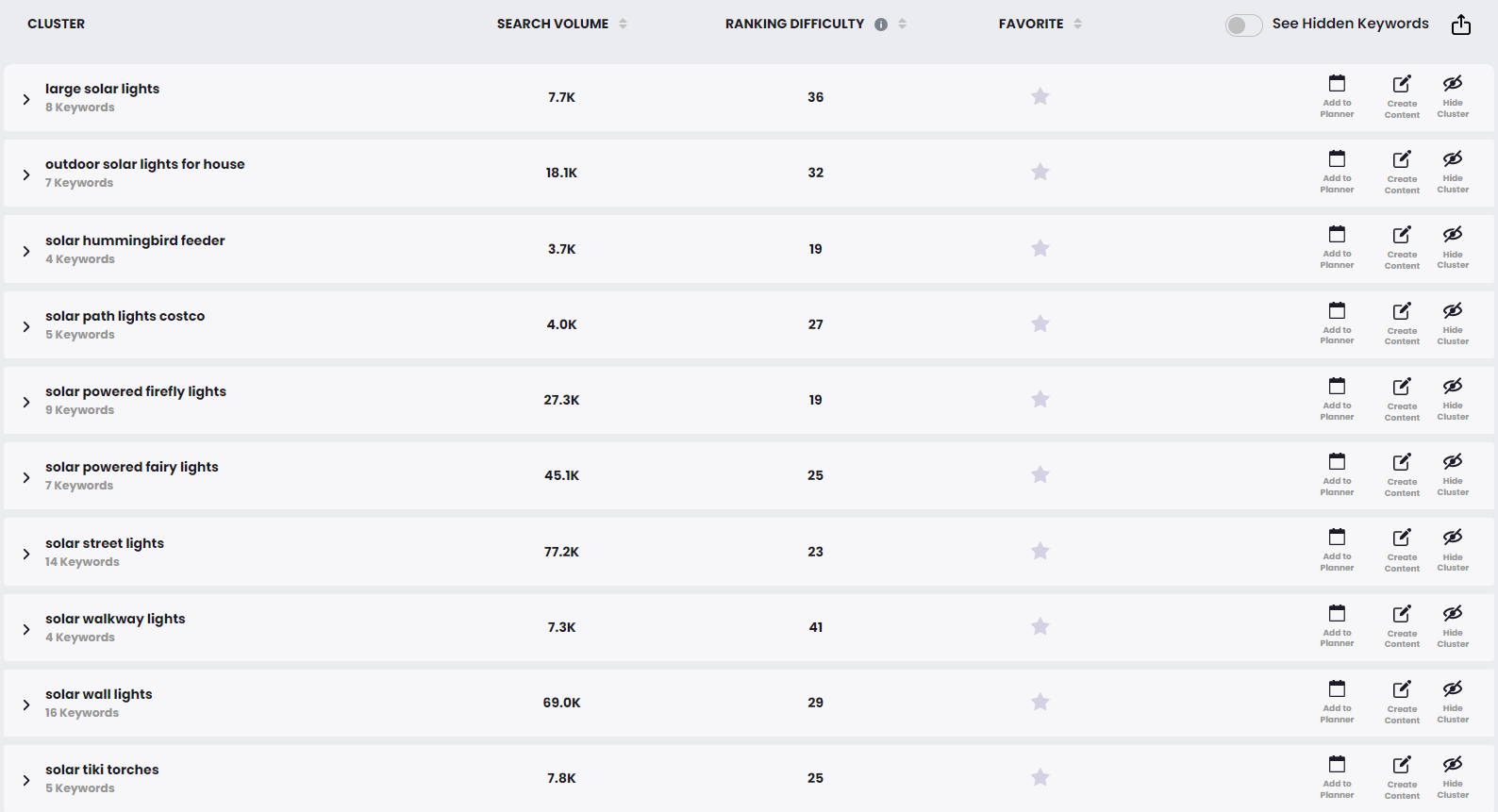Discover top guides, trends, tips and expertise from AIO Writers
Keyword Clusters are Worth the Work (Here’s Why…and How)
Julia McCoy
Wednesday, 6th Jul 2022
If you’re a small business owner or marketing manager, chances are you’ve heard of a keyword cluster. This SEO strategy involves grouping together similar keywords to target a specific audience with your content.
For example, let’s say you own a women’s clothing store. You might create a keyword cluster around the following terms: “women’s clothes,” “ladies’ fashion,” and “women’s apparel.” By targeting these related keywords, you can attract searchers who are specifically looking for what you have to offer.
But is all this effort really worth it? In short, yes! Here’s why keyword clustering can be such an effective advanced SEO strategy.
What is Keyword Clustering?
Keyword clustering, also known as topic clustering, refers to the grouping of related keywords that collectively cover a broad subject area or search intent. These clusters not only provide context and support for various pages within a group but also play an integral role in structuring your internal linking system.
The idea behind keyword clustering is simple: instead of relying on one single keyword and potentially missing out on valuable online market share, you can create keyword clusters to address different topics. This approach allows you to rank for primary keywords, short-tail keywords (keywords with high search volume), and long-tail keywords (specific phrases with lower search volumes) within the same blog post.
Differentiating Between Seed Keywords and Secondary Keywords
To build effective clusters, you need to understand seed keywords and secondary keywords.
Seed keywords are the foundation upon which we construct our cluster strategy, whereas secondary keywords add depth by catering to long-tail searches with specific intent.
Broadly speaking, seed phrases define what your product or service offering revolves around. They form the basis for generating related long-tail phrases or questions potential customers might use during their online search.
Semrush illustrates below how a seed phrase (“king mattress”) serves as the primary anchor within the cluster framework, with secondary keywords (“mattress king size”, “king size mattress”, etc.) surrounding it.

Here’s another example of keyword clustering from ZenBrief:

The Role of SEO in Keyword Clustering
If you’re familiar with digital marketing practices, then chances are you’ve heard about Search Engine Optimization (SEO). As an essential component of any successful online strategy, SEO involves optimizing your content so it can be found organically through search engines like Google.
In this regard, using clustered keywords helps streamline your SEO efforts by targeting multiple related terms at once. It’s all about understanding the user’s search intent — what they’re looking for when they type certain words or phrases into a search engine — and providing them with relevant results based on those queries.
Keyword clusters help you identify a large number of keywords surrounding a similar topic.
For instance, “toasters” may include “best toaster,” “how to toast bread,” and “what type of bread makes the best toast.” Imagine how many dozens, or hundreds, of articles, are closely or loosely related to toasters. This can be helpful when you’re trying to target a specific audience or market.
If you only attempt ranking for “toaster” or “best toaster,” you do more than limit your market.
Google more clearly sees your goal is to rank for one keyword — not serve those looking for good toast.
But if they see you trying to serve the search intent of all toast searchers, they’ll be more likely to reward your content with spots in the top 10.
If you want your web page to rank for big “money” or “transactional” keywords, focus on related subtopics. This will often result in your page ranking for 10-20x the number of keywords and increased traffic.
Google has focused its engineering efforts on understanding natural language and the relationships between on-page content in the past couple of years.
Neural matching has helped search engines better understand synonyms.
With each new update to its core algorithm, Google is becoming more and more like a book.
Many website owners are still optimizing their sites with only a few keywords in mind, despite Google’s increasing intelligence. This outdated method can lead to your landing page being ranked for hundreds of irrelevant search terms.
This outdated practice is unnecessary, especially since we know that our landing pages are usually ranked for hundreds, if not thousands, of different search terms.
For some of us who have been in the SEO game since the beginning, this feels a little like a new frontier.
As Google’s NLP technology continues to evolve, our on-page SEO strategy must also adapt to reflect these changes. This will ensure that our content is properly optimized for search and provides the best possible experience for users.
How do we optimize our on-page SEO to keep up with Google?
Clustering keywords is the solution.
Benefits of Using Keyword Clusters
Keyword clustering is a strategy that requires you to spend a lot of resources on a certain topic, through multiple (often dozens or more) articles. This strategy requires extensive amounts of research, planning, and implementation.
However, once the plan is in place, it often provides months (if not years) of content ideas, as it needs more keyword research, more topics for blog posts, and more.
In the end, creating clusters of related keywords and topics on your site will make it easier for search engines to crawl and index your site. The benefits also include:
- High rankings for low comp, long tail keywords (often in the top 10).
- Overall better rankings for main keywords of the same topic.
- More pageviews, sessions, and visitors.
- Achieve results quickly (with bulk publishing).
- A strong interlinking profile (since so many articles are similar, yet unique).
- The non-SEO-related benefits (including your site becoming an authority in the space).

Screenshot from Moz
Why Keyword Clustering is Essential
Using keyword clustering, you can target multiple keywords at once, giving you an edge over your competition.
This is because they respond to Google’s powerful search, which utilizes its natural language and indexing capabilities.
Think about this. Search engines like Google understand all the various keywords and key phrases that individuals use across different industries and topics. This allows them to provide you with results that are specific to what you are searching for.
It understands that certain words or phrases are related while others are not.
Google has spent years developing its natural language processing (NLP) algorithms, which are designed to interpret the content of a web page and determine how relevant it is to the query.
When you create multiple pages with content that covers the same topic, you demonstrate to search engines that your site is an authoritative source and is packed full of useful, in-depth information.
You also give search engines like Google rich, informative content that helps them identify what your site is about and rank it accordingly.
In a keyword cluster, you need to think bigger than just keywords. It’s the way of the future.
If you really want your pages to stay at the top of search results, it’s high time that you pay attention to your on-page SEO.
How Does Keyword Research Fit In?
Keyword research tools help identify popular terms associated with your seed keyword – the main term around which other secondary ones revolve – thus helping prevent potential issues like keyword cannibalization.
Keyword cannibalization happens when multiple pages on your site end up competing against each other because they target similar terms. Not cool.
Creating keyword clusters all starts with a good old-fashioned session of keyword research. We’ve got some great tools in our arsenal for this: think Google’s Keyword Generator or maybe even Semrush.
Look for short-tail keywords (those snappy one-to-three-word phrases) and long-tail keywords (longer, less competitive but oh-so-specific). Balancing these two types is like having your cake and eating it too when it comes to ranking on SERPs.
How Keyword Clustering Streamlines Your SEO Strategy
The magic ingredient in your search engine optimization mix? It’s keyword clustering. This strategy doesn’t just make organizing content a breeze; it also boosts team productivity by providing everyone with the same roadmap for success.
But there’s even more to this story. The true beauty of keyword clusters lies in their power to increase visibility on search engine results pages (SERPs). By bundling related keywords together, you’re essentially creating a rich tapestry that makes sense not only to human readers but also to search engine crawlers.
And when they understand what your site is about? That’s when you start climbing up those rankings.
You know what else loves clustered keywords? Google featured snippets.

These are like little golden tickets at the top of SERP results that directly answer user queries — and using relevant grouped keywords can help secure these coveted spots.
Create Keyword Clusters in One Click
Keyword clustering doesn’t have to be difficult and time-consuming. With BrandWell, all you have to do is enter a seed keyword and the AI will generate a list of relevant keywords that are already grouped for you.
In the example below, I used BrandWell to build topic clusters for my solar lighting website. As you can see, I now have 10 clusters with 4-16 keywords each — ready for blog generation.
By simply clicking the “Create Content” button in the Action Panel, I can have an entire network of long-form, in-depth articles going live on my blog!

I can also add them to my Content Planner for publication at a later date, or hide clusters that may not seem relevant to my niche.
Preparing For the Future with Keyword Clustering
The world of digital marketing is always evolving. As search engine algorithms and user behaviors continue to change, it becomes essential for us to stay ahead by mastering techniques like keyword clustering.
This isn’t just a fleeting trend in SEO practices; its benefits are substantial and long-lasting. By reducing the risk of keyword cannibalization, you ensure your content doesn’t compete against itself on SERPs.
An understanding of user intent has become increasingly crucial in modern-day SEO strategies. Google’s algorithm updates have shifted focus towards satisfying user queries rather than merely matching keywords. This shift emphasizes why strategies like keyword clustering will remain important — they allow businesses to create more relevant content that satisfies their audience’s needs comprehensively.
Digital marketers should keep an eye out for trends such as voice search optimization and AI-powered analytics tools which could impact how we approach keyword research going forward.
If technology continues advancing at breakneck speed, staying updated with these developments will be key for maintaining a competitive edge.
Overall, a keyword cluster is a great way to improve your SEO and attract more targeted traffic to your website. So if you’re not already using this strategy, it’s definitely worth considering!

UNLOCK YOUR POTENTIAL
Long Headline that highlights Value Proposition of Lead Magnet
Grab a front row seat to our video masterclasses, interviews, case studies, tutorials, and guides.



